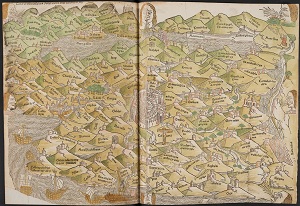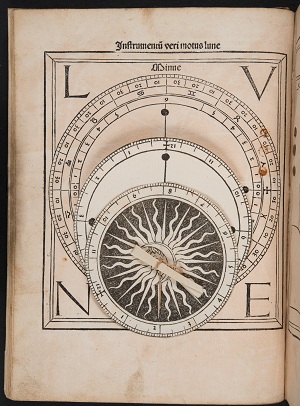World’s oldest printed books soon available for your viewing pleasure
Published: 24 February 2015
A new exhibition at the Hunterian Art Gallery will mark the end of a project to create a unique publicly accessible digital catalogue of over 1,000 of the world’s oldest books.
A new exhibition, opening at the University of Glasgow’s Hunterian Art Gallery this Friday will mark the end of a project to create a unique publicly accessible digital catalogue of over 1,000 of the world’s oldest books.
The new digital catalogue will contain a record of landmark books dating from the dawn of the age of printing, over 500 years ago. Amongst the important collection is a book containing the very first map ever printed and a moving astronomical calendar, which uses adjustable paper wheels which can be operated to show the motion of the Moon.
The ‘Ingenious Impressions’ exhibition launch will mark the end of a six year project to comprehensively research the origins and history of each of the 1,050 pre-15th century books held at the University of Glasgow’s collection. The team have already uploaded digital records of 950 books, with the remaining 100 books due to be added before the close of the exhibition.

Books dating back to before 1501 are known as ‘Incunables’. The collection which is held by the University of Glasgow Library’s Special Collections Department, is one of the largest in the UK. This is the first time that a selection of the University’s 15th century books will ever have been on display together.
On display will be 64 of the most remarkable Incunables, including:
- ‘Rudimentum Novitiorum’ (Lucas Brandis, 1475) – A history of the world containing the very first printed map known to exist, a map of Palestine. The map depicts a stylised bird’s eye view of the Holy Land.
- ‘Kalendarium’ (Johannes Regiomontanus, 1482) – Pioneers the use of moving instruments called ‘volvelles’ (or paper wheels), which were used to do astronomical calculations including predicting lunar cycles and eclipses. The book, which still works after over 500 years, contains written confirmation in the annotations that these eclipses were accurately predicted years before they occurred.
- Das Narrenschiff (Sebastian Brant, 1498) – This is often cited as the world’s first bestseller and was one of the most successful publications of its age. The book was originally printed in German but later translated into English under the title ‘The Ship of Fools’. It is an illustrated work of satire that is surprisingly modern in outlook, criticising various parts vices of the late 15th Century – especially the Church. It also includes the corrupt judge, the drunkard and the untrained physician.
The research on the Glasgow Incunabula Project was undertaken by Jack Baldwin (Honorary Research Fellow) and is managed and assisted by University of Glasgow Library’s Rare Books Librarians, Julie Gardham and Robert Maclean. They have been researching the content of every book and the journeys they made before they came in to the University’s possession.
Julie said “We are delighted to be able to launch this digital resource which I hope will encourage more people to find out about these incredible books and their histories.
“It may seem strange to us today, but when published these books were at the forefront of an information revolution driven by a new technology – printing. It was this technological advance that powered the Renaissance and led to the spread of learning across Europe and beyond.
These books are significant, not only because their content offers us a unique window into history, but also because they signify a crucial shift in the human story.”

The University of Glasgow’s incunabula collection is the largest in Scotland with over a thousand copies housed in the University Library. More than half come from the collection of Hunterian founder Dr William Hunter (1718-83).
The exhibition, ‘Ingenious Impressions: The Coming of the Book’, will run at the University’s Hunterian Gallery from the 27 February - 21 June 2015. A selection of the most remarkable works from the Incunabula project have been reprinted in a catalogue accompanying the ‘Ingenious Impressions’ exhibition.
‘Ingenious Impressions’is the first major exhibition at the Hunterian to explore the development and subsequent afterlives of these fascinating works. Showcasing the University’s rich collections and the results of new research from the Glasgow Incunabula Project, ‘Ingenious Impressions’charts the development of the early printed book in Europe, exploring the transition from manuscript to print culture, and focusing on unique features such as their provenance, decoration and use by early readers.
Media enquiries: leila.khoshoie@glasgow.ac.uk / 0141 330 3683
Notes for editors:
- More information on the exhibition is available on the Hunterian’s website: www.gla.ac.uk/hunterian/visit/exhibitions/major%20exhibitions/ingeniousimpressions/
- Incunabula’ are early printed books published over the fifty years from the invention of printing in the mid-15th century. Over 30,300 editions of different texts are known to have been produced during the 15th century, in print runs of anything from 100 to 1400 copies. The total number of books printed prior to 1501 has been estimated at being anything from 8 million to 20 million items.
- Often printed in small editions of a few hundred copies, many incunables are now rare. Their numbers have greatly reduced over the centuries by usage and assorted calamities. The University of Glasgow collections have their share of rarities: 11 are unique and a further 67 are editions unrecorded in any other library in the UK.
First published: 24 February 2015
<< February

